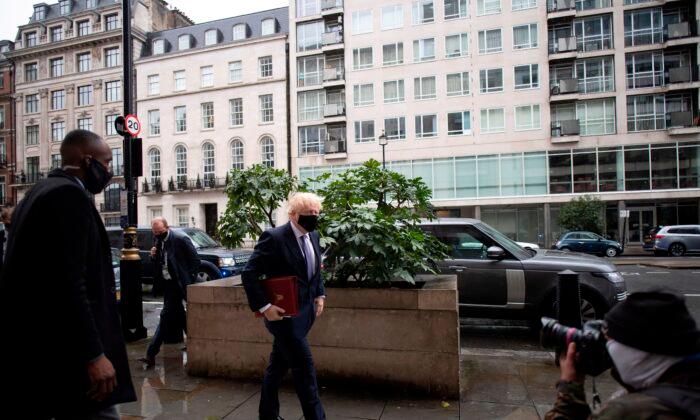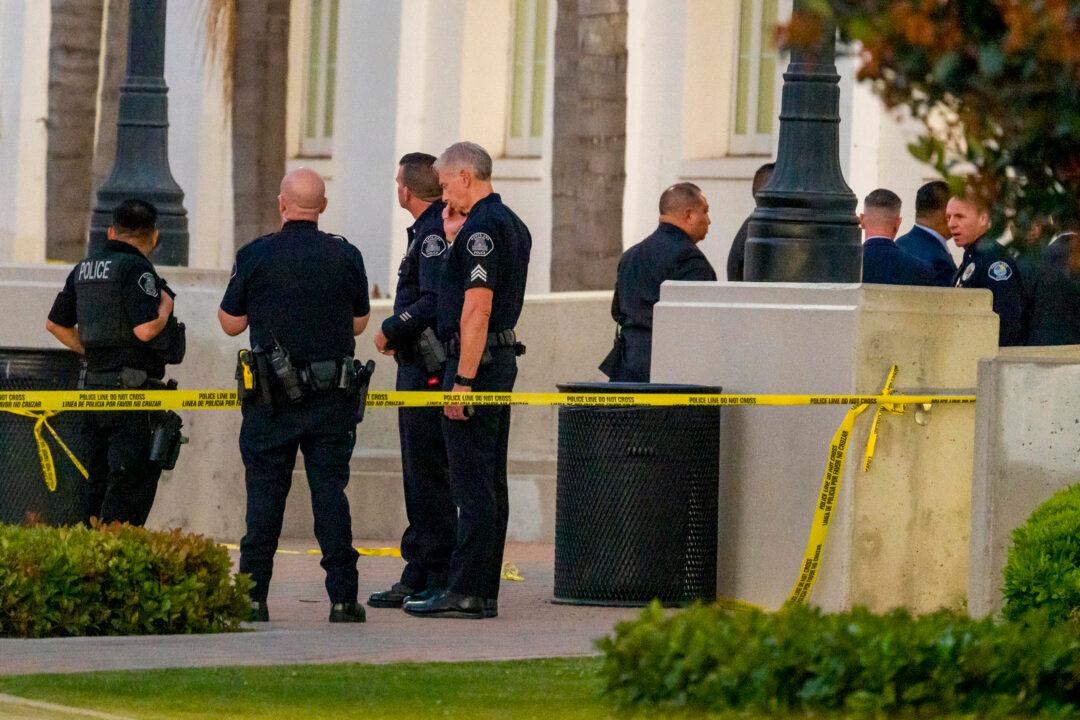LONDON—British Prime Minister Boris Johnson defended his handling of the coronavirus pandemic on Oct. 4 despite weeks of rising infections but warned that the country faced a “bumpy” winter ahead.
Britain has Europe’s highest coronavirus death toll, at more than 42,400, and Johnson’s Conservative government is facing criticism from all sides. Opponents say tougher social restrictions are needed to suppress a second wave of COVID-19 that is already sweeping the country. But many in Johnson’s right-of-center party argue that restrictions must be eased to save the battered economy.
Johnson told the BBC the government had to strike a difficult balance and he couldn’t “take a course that could expose us to tens of thousands more deaths in very short order.”
“It is a moral imperative to save lives ... but on the other hand, we have to keep our economy moving. That is the balance that we are trying to strike,” he said.
Britain went into a national lockdown in March, with most businesses closed and all but essential travel barred. Restrictions began to be lifted in June as the pandemic tide receded. But like other European countries, daily new coronavirus infections began to rise again when pubs and restaurants reopened, children went back to school and students returned to university.
The U.K. is now under national restrictions on socializing, including a 10 p.m. curfew for bars and restaurants, and groups limited to six, with areas of high infection facing stricter local measures, which Johnson and other ministers have sometimes struggled to explain clearly. Critics say months of mixed messages and changes of advice on everything from wearing masks to whether or not to work from home has left people confused and exhausted.
A national test-and-trace program to find people who have been exposed to the virus has also had persistent problems and is failing to reach more than a quarter of infected people’s contacts.
Keir Starmer, leader of the opposition Labour Party, accused the government of “serial incompetence.”
“The prime minister is governing in hindsight,” Starmer told the Observer newspaper. “So he charges forward, not recognizing the problem, has a car crash, looks in the rear mirror and says: ‘What’s all that about?’”
Johnson said he knew many people were furious with him over perceived inconsistencies and confusion surrounding the local measures, but he was seeking to strike a balance between public health and the wider needs of society and the economy.
“In these areas, and I appreciate the fatigue that people are experiencing, but we have to work together, follow the guidance and get the virus down whilst keeping the economy moving, that’s the balance we’re trying to find,” he said in an interview on BBC television.
Britain recorded 12,872 new coronavirus infections on Oct. 3, by far the highest daily total since the outbreak began, although the figure includes a backlog of previously unreported cases. The daily number can’t directly be compared to U.K.’s peak in April because many more tests are being performed now.
The number of hospitalizations and deaths in Britain is also rising but remains far below the U.K.’s springtime peak. Another 49 COVID-19 deaths were reported on Oct. 3, compared to almost 1,000 a day at the height of the outbreak.
Johnson acknowledged that many people feel “fatigue” after months of restrictions and expressed hope that progress on vaccines and testing would “change the scientific equation” in the next few months, allowing a return to normality.
But he warned “it’s going to continue to be bumpy through to Christmas. It may even be bumpy beyond.”
During his Oct. 4 interview, Johnson denied a suggestion that the local restrictions were not working given infection rates were still rising in the affected areas and there was no end in sight to the measures.
“I’m afraid it’s simply too early to say,” he said, adding that the advice to the government was that it was necessary to wait and see if the R number, the reproduction rate of the virus, started to come down.
Striking a more optimistic note, Johnson said he expected the scientific equation to change over the coming months with progress on testing and on vaccines, which would enable the government to take a different approach.
“If you talk to the scientists, they’re all virtually unanimous that by the spring things will be radically different and we'll be in a different world, that is the normal cycle of a pandemic like this,” he said.
“This is a pandemic in which people need to understand that there is hope,” he said. “We will get through this very well.”
Meanwhile, Spain’s capital Madrid has become Europe’s biggest hotspot in the second wave of the coronavirus, beginning its first day on Oct. 3 under a partial lockdown, with police controlling travel in and out of the city.
The measures prohibit all nonessential trips in and out of the capital and nine of its suburbs—affecting around 4.8 million people. Restaurants must close at 11 p.m. and shops at 10 p.m., and both must limit occupancy to 50% of their capacity.





